

Art instruction and other fun stuff by Debra Pero.




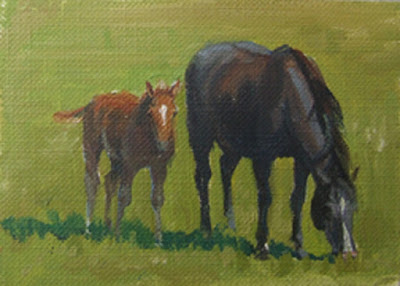
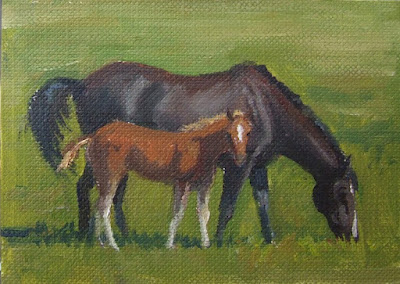 I just love painting horses. These two are tiny little art cards - 2.5 x3.5 inches.
I just love painting horses. These two are tiny little art cards - 2.5 x3.5 inches. We've got that group show this coming weekend, and I got a late start (VERY late) in painting work for this show, so I've been staying up till all hours trying to finish some works. I believe I have painted about 20 paintings in the last 3 or 4 weeks, with all kinds of interruptions, and the holidays, etc. etc. This one is large - I did several fair sized works - not huge, but bigger than my usual. There will be a couple of 18x24's and some 16x20's. And then lots of little ones too.
We've got that group show this coming weekend, and I got a late start (VERY late) in painting work for this show, so I've been staying up till all hours trying to finish some works. I believe I have painted about 20 paintings in the last 3 or 4 weeks, with all kinds of interruptions, and the holidays, etc. etc. This one is large - I did several fair sized works - not huge, but bigger than my usual. There will be a couple of 18x24's and some 16x20's. And then lots of little ones too. I'm putting in a plug for what promises to be a fabulous, informative painting workshop up in the White Mountains, near Franconia Notch. The workshop will be Jan. 30-Feb. 1, taught by Stapleton Kearns. Lodging will be at the Sunset Hill House, pictured above.
I'm putting in a plug for what promises to be a fabulous, informative painting workshop up in the White Mountains, near Franconia Notch. The workshop will be Jan. 30-Feb. 1, taught by Stapleton Kearns. Lodging will be at the Sunset Hill House, pictured above. 
 "The Crossing" 2.5 x3.5" Artist Trading Card
"The Crossing" 2.5 x3.5" Artist Trading Card "Taking a Break" 2.5 x 3.5" Artist Trading Card
"Taking a Break" 2.5 x 3.5" Artist Trading Card Silver and Orange, 2.5 x 3.5 Artist Trading Card
Silver and Orange, 2.5 x 3.5 Artist Trading Card (this is a study done from an original painting by Richard Schmid) It has nothing to do with tonight's post except I just thought I needed a photo!
(this is a study done from an original painting by Richard Schmid) It has nothing to do with tonight's post except I just thought I needed a photo!

 Just thought I'd post one more mini. This one is about 3x4, and it titled "Going in for the Night". I did several winter scenes for this show, and most of them are the moody, gray winter days that we all endure so much of the time in New Hampshire. However, this one is sunny because the shadows are what really creates the design in this one.
Just thought I'd post one more mini. This one is about 3x4, and it titled "Going in for the Night". I did several winter scenes for this show, and most of them are the moody, gray winter days that we all endure so much of the time in New Hampshire. However, this one is sunny because the shadows are what really creates the design in this one.


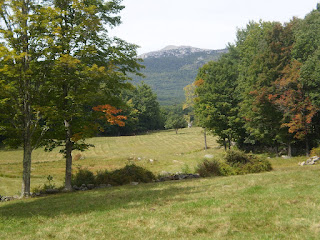
Flashback! Remember that song by Procal Harem? A "whiter shade of pale" is a good catch phrase for today's lesson.
Just remember the principle of “more and less.”
Close objects in a landscape have
MORE intense, pure color.
MORE contrast in values (between light and shadow sides)
MORE defined edges
MORE detail
Distant objects in a landscape have:
LESS intense, pure color.
LESS contrast in values. (between light and shadow sides)
LESS defined edges
LESS detail.
Yellow is the first color to "drop off" as distance increases. That means that any object whose color is yellow, or contains yellow (greens, browns, oranges, warm reds, etc.) will lose more and more of that yellow hue as they get further away. You'll need to lighten and gray the yellow to portray this distance. Gray it by adding its compliment, purple. You might also want to consider using a cooler version of yellow in the mix. For example, a bright yellow clump of daffodils up close could be painted with almost pure cadmium yellow light. Far away, that daffodil color might be better represented by mixing some cad lemon ( a "cooler" yellow) with white and its compliment, purple. (or a mix of ultramarine and alizarin) Sometimes I've also used yellow ochre for a situation like this, as it is a cooler, duller, grayer version of yellow.
Red is the next color to drop out of the equation. So, reds tend to get cooler, and more pinkish purple as they get further away.
Blue is the last color to drop off. That is why we often see distant mountains as blue. all the red and yellow have diminished and we're left with those bluish notes.
As objects recede into distance, color will get lighter and grayer and COOLER in temperature. All the colors fade out and lighten to eventually reach a pale gray. (remember that song title?)
White is the only exception to this rule. White gets darker and grayer..
See illustration above to see how this works in practice. A red barn and tree are shown close up, mid-distance, and far away. The color swatches show the shadow and light colors of each group. The swatches are the shadow and light sides of barn color, tree color, grass color and barn door color.
Notice how the color, the temperature, and the values changes.
Close up: Colors are rich, warm, and intense. There’s a lot of difference in value between
the light and shadow sides. The inside of the barn door is a deep warm black. Details are evident.
Mid-distance: The colors have gotten slightly cooler, and grayer in tone.. There is not as much difference in value between light and shadow sides. Not as much detail is evident, and the black of the barn door opening is now a dark purplish brown.
Far away: The colors have really gotten lighter, and grayer. There is barely any difference in value between light and shadow sides – really only color temperature notes the difference. The deep shadow of that barn door is now a purplish blue.





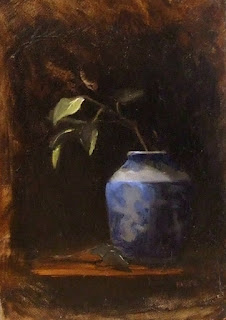
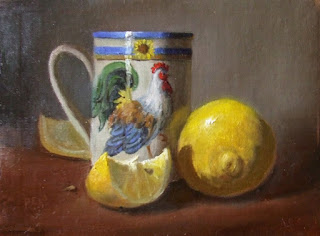 Here are two small still lifes. I'm using them as an example of a principle about light and shadow and background color.
Here are two small still lifes. I'm using them as an example of a principle about light and shadow and background color. I have always felt that being able to spend time doing what I love so much is a real blessing. I'm quite thankful to paint full time, with all the
I have always felt that being able to spend time doing what I love so much is a real blessing. I'm quite thankful to paint full time, with all the


Color Camp
Not rules, but tools!
As artists, we want to use all the tools at our disposal to help us create good, solid paintings. These 3 sessions are designed to review some basic principles of color that can help us make intelligent choices as we work. Consider these some added “weapons” in your arsenal or tools in your toolbox that you can pull out when you need them!
We won't be trying to complete polished paintings, but rather we'll tackle some exercises to re-enforce each day's lesson. In addition, each day we'll look at a "problem painting" that contains a common error. Heck, it might have several problems! Based on our color lessons, the class will "dissect" the poor painting and decide what's wrong and how to fix it, and then you'll get a chance to create your own "new and improved" version!
Session 1: When You’re Hot, You’re Hot!
Color Temperature: It matters!
Why can’t I use the same colors to paint an orange that is sitting on my kitchen table as an orange sitting outside on my deck railing? In other words, how does outside light differ from inside light? One word: COLOR TEMPERATURE! (okay, okay, that's two words). Tip: This might be very useful info if you want to paint still life or landscape... or interiors.. or figures inside or outside... or old cars rusting under a tree... or maybe a package of neon gummi worms....
Where is this orange? Outside or inside?
Session 2. Good Morning, Sunshine!
Portraying Time of Day in Your Landscape
What’s the difference between morning light and late afternoon light? Is there a difference? How do we make our paintings look like morning, noon, or evening?
Look at this poor painting. I can't tell what time of day it's supposed to be. And there are some other real errors. Should we shoot it and put it out of its misery? Wait, there's hope! Come find out how we can correct and improve this baby.
Session 3. Way Over Yonder…..
The effects of Atmosphere on Color.
When is a red barn not red? What happens to autumn foliage on that distant hillside?
This painting has a problem. Actually, it has several glaring problems, and these problems are common errors that can be avoided by understanding some simple principles of color and design.
Do you know how to fix this painting?
Well, come join us for some fun as we focus on color! There are about 3 spots left in the class.


 We meet and set up at 9am, and paint till the cows come home. Seriously. No kidding. The cows wander over near our easels in the morning, and then they go up the hill to the high pasture. In the evening, around suppertime, they come plodding back down to where we are. We paint until there's not enough light left to paint, and then we've been going out together as a group and eating dinner and debriefing the day's work.
We meet and set up at 9am, and paint till the cows come home. Seriously. No kidding. The cows wander over near our easels in the morning, and then they go up the hill to the high pasture. In the evening, around suppertime, they come plodding back down to where we are. We paint until there's not enough light left to paint, and then we've been going out together as a group and eating dinner and debriefing the day's work.